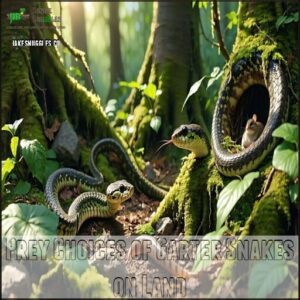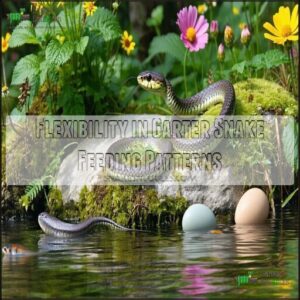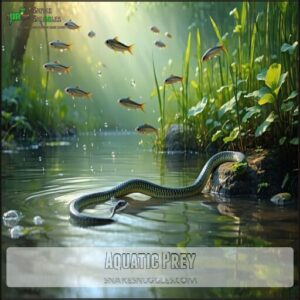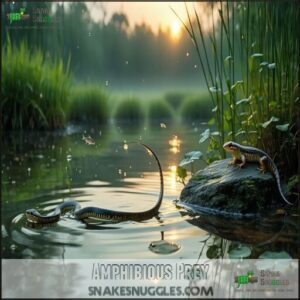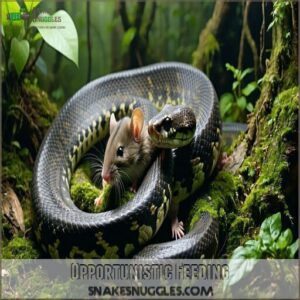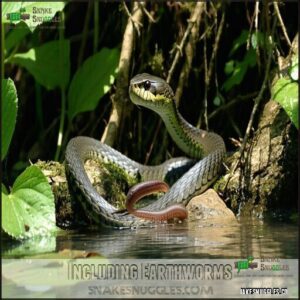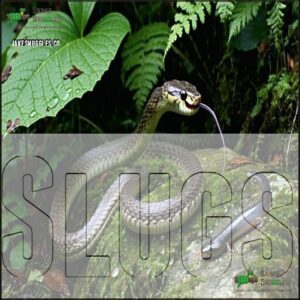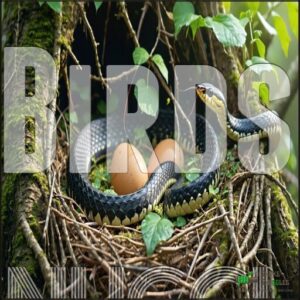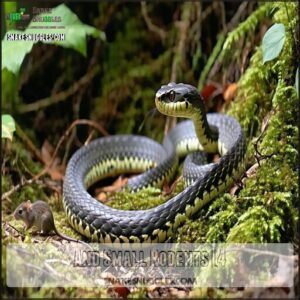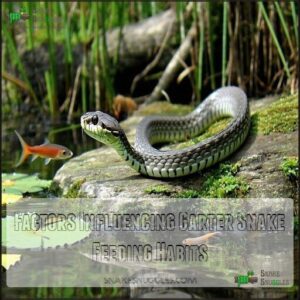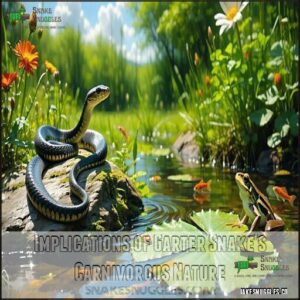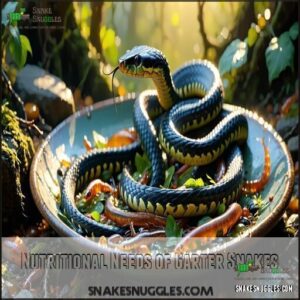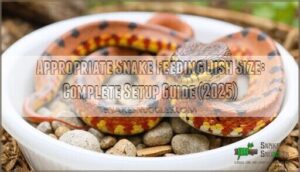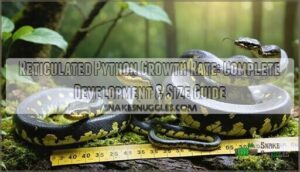This site is supported by our readers. We may earn a commission, at no cost to you, if you purchase through links.
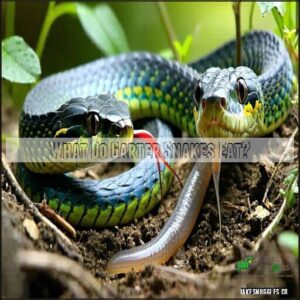 If you’re wondering what garter snakes eat, you’re in for a wild ride!
If you’re wondering what garter snakes eat, you’re in for a wild ride!
These slithery predators aren’t picky—they’ll chow down on everything from earthworms and slugs to frogs, fish, and tiny rodents.
You’ll find them hunting both on land and in water, using their quick reflexes to catch prey.
Their diet’s so flexible that they can adapt to different environments faster than you can say "snake snack!"
Whether they’re living near streams, ponds, or your backyard, these serpents are opportunistic hunters that’ll gobble up whatever tasty morsel crosses their path.
Trust me, a garter snake’s menu is anything but boring, with a diet that includes everything from earthworms to tiny rodents.
Table Of Contents
- Key Takeaways
- What Do Garter Snakes Eat?
- What Are The Dietary Preferences of Garter Snakes?
- Prey Choices of Garter Snakes on Land
- Flexibility in Garter Snake Feeding Patterns
- Varied Prey Selection Near Water Sources
- Managing The Diet of Pet Garter Snakes
- Factors Influencing Garter Snake Feeding Habits
- Implications of Garter Snake’s Carnivorous Nature
- Nutritional Needs of Garter Snakes
- Adapting Captive Garter Snakes’ Diet to Wild Preferences
- Frequently Asked Questions (FAQs)
- Why do garter snakes smell bad?
- Do garter snakes eat mice and voles?
- Do garter snakes bite and are they dangerous?
- What is a garter snakes’ favorite food?
- Is it good to have garter snakes in your yard?
- Do garter snakes eat mice?
- Does a garter snake bite hurt?
- What is a garter snake’s favorite food?
- What attracts garter snakes to your house?
- Are garter snakes good to keep around?
- Conclusion
Key Takeaways
- You’ll discover garter snakes are incredibly flexible predators that eat a wide variety of prey, from earthworms and slugs to small rodents, frogs, and fish, adapting their diet to whatever’s available in their environment.
- Their hunting skills aren’t limited to one habitat—you’ll find them catching prey on land and in water, using lightning-fast reflexes to swallow meals whole that match their body width.
- As opportunistic carnivores, you’ll see them transform different landscapes into personal buffets, strategically targeting prey like tadpoles, salamanders, insects, and even small birds depending on seasonal availability.
- If you’re keeping a garter snake as a pet, you’ll need to carefully manage their diet by providing frozen-thawed mice, earthworms, and fish pieces, ensuring the prey is appropriately sized and nutritionally balanced to support their health.
What Do Garter Snakes Eat?
Explore the realm of garter snakes and uncover their surprising diet!
These cunning predators feast on a smorgasbord of prey, from wriggling earthworms to tiny rodents.
Slithering strategists of survival, garter snakes turn nature’s landscape into their personal all-you-can-eat buffet!
Adapting like culinary chameleons, they switch up their menu based on habitat—snatching frogs near water or hunting insects on land.
Their flexible digestive system allows them to swallow prey matching their body width, ensuring a diverse and nutritious meal every time.
Understanding baby snake feeding is vital for their survival and growth.
What Are The Dietary Preferences of Garter Snakes?
Ever wondered how garter snakes turn their environment into a movable feast?
These slithery survivors aren’t picky eaters—they’re nutritional ninjas adapting to whatever nature serves up! Their garter snake diet transforms with the landscape, turning seasonal shifts into a culinary adventure.
Nature’s masterful adaptors: garter snakes transform landscapes into their personal, ever-changing buffet!
- Prey Flexibility: Switch menu based on habitat
- Environmental Adaptation: Hunt what’s available
- Nutritional Opportunism: Maximize food sources
Their feeding strategies reveal nature’s ultimate survival blueprint.
From woodland floors to wetland edges, garter snakes prove that being adaptable isn’t just smart—it’s delicious.
Prey Choices of Garter Snakes on Land
When hunting on terra firma, garter snakes become masterful predators with diverse appetites.
Their land-based diet includes a surprising array of prey that’ll make your jaw drop:
- Tiny mice scampering through undergrowth
- Wriggling earthworms hiding in soil
- Ground-dwelling insects and larvae
- Small lizards darting between rocks
- Unsuspecting baby birds nestled nearby
These resourceful reptiles adapt their snake feeding habits to whatever prey crosses their path, transforming local landscapes into hunting grounds.
Their flexible garter snake diet guarantees survival through opportunistic small mammal and insect capture, proving nature’s ultimate survival strategy.
Understanding their snake diet preferences is vital to appreciating their role in the ecosystem.
Flexibility in Garter Snake Feeding Patterns
Garter snakes rewrite the rulebook on survival with their remarkable feeding adaptation.
These serpentine survivors transform their diet based on seasonal shifts and environmental cues, turning their nutrition into a dynamic game of culinary roulette.
Whether facing sparse landscapes or abundant ecosystems, they’ll switch from slugs to small birds without missing a beat.
Their dietary flexibility isn’t just impressive—it’s a demonstration of nature’s incredible survival strategies, allowing these remarkable reptiles to thrive in diverse habitats, showcasing their ability to adapt with seasonal shifts and environmental cues.
Varied Prey Selection Near Water Sources
You’ll be amazed by how gartner snakes transform water sources into their personal buffet, scouting for a diverse menu of aquatic prey.
These adaptable predators can quickly snatch up salamanders, frogs, tadpoles, and even small fish with lightning-fast precision near ponds, streams, and marshy environments.
Aquatic Prey
Water transforms into a buffet for adaptable garter snakes.
These slithery hunters navigate aquatic ecosystems with remarkable skill, targeting fish prey like minnows, frog eggs, and water snails.
Their diet includes small, defenseless creatures: crayfish, aquatic insects, and tadpoles.
By leveraging their flexible aquatic adaptation, these serpents turn underwater environments into their personal hunting grounds, demonstrating nature’s ingenious survival strategies, showcasing their ability to thrive in various environments with remarkable skill.
Garter Snakes Living Near Ponds
Ponds serve as a feast for these slithery predators, offering a smorgasbord of aquatic delicacies.
Garter snakes exploit pond ecology with strategic hunting techniques, targeting vulnerable prey in their watery domain.
- Prey diversity thrives in these liquid landscapes
- Water quality impacts snake habitat selection
- Small fish become unexpected meals
- Amphibian populations fuel snake survival
Their adaptable diet transforms ponds into personal hunting grounds, making them a crucial part of the ecosystem, with strategic hunting techniques being key to their survival.
Streams
Slithering through five distinct stream ecosystems, garter snakes become masters of river dynamics, hunting aquatic life with remarkable precision.
Their diet transforms with water quality and shoreline habitats, targeting small fish, salamanders, and agile prey swimming nearby.
These adaptable predators turn stream ecology into their personal hunting ground, ensuring survival through strategic feeding techniques.
Tadpoles
Near streams and ponds, tadpoles become quick meals for hungry garter snakes.
These wiggly aquatic creatures offer an easy target in frog eggs and larval stages, providing rich nutrition for these opportunistic predators.
Their slow movement makes them perfect prey in diverse water quality environments, becoming a key component of the garter snake’s diverse diet.
Frogs
Garter snakes love gobbling up frogs in their native frog habitats! These nimble predators track down various frog species, making amphibians a prime menu item.
Inhabiting streams and ponds, they’ve mastered the art of catching unsuspecting prey. Their dietary strategy transforms frogs from potential pond residents into quick protein-packed meals, showcasing nature’s raw survival tactics.
Understanding the snake frog interactions is essential for grasping the ecosystem balance.
And Salamanders [3
Frogs aren’t the only tasty treat for these water-loving hunters.
Salamanders make a prime dish in the garter snake’s wild menu.
These amphibian prey hide in mossy stream banks, waiting to become a snake’s lunch.
- Spotted salamanders thrive in moist woodland habitats
- Streams provide perfect hunting grounds for garter snakes
- Soft-bodied amphibians offer rich nutritional value
- Camouflage doesn’t always protect from keen snake senses
Amphibious Prey
Water sources teem with life, and garter snakes know exactly how to capitalize on this buffet!
These cunning predators excel in frog habitats, hunting an impressive amphibian diet that keeps them thriving:
- Snatching wriggling tadpoles whole
- Capturing salamanders with lightning speed
- Devouring small aquatic fish
- Targeting leeches and slippery prey
Their aquatic foods showcase incredible hunting skills. Unlike other predators, garter snakes swallow wild amphibians in one swift motion, turning ponds and streams into their personal hunting grounds.
Nature’s perfect opportunistic hunters strike with precision, making every water source a potential meal.
Opportunistic Feeding
Every hunter has a secret weapon, and for garter snakes, it’s their jaw-dropping prey selection strategy.
These opportunistic carnivores adapt their feeding habits to whatever crawls, swims, or slithers nearby.
Their hunting techniques transform each environment into a buffet of possibilities, maximizing food sources through incredible dietary flexibility.
They’re nature’s ultimate survival experts, turning limitations into advantages.
Including Earthworms
Countless earthworms become irresistible prey for garter snakes lurking near water sources.
Their slimy, wriggling bodies trigger a snake’s lightning-fast hunting instincts, making them a nutritional staple in wild foraging.
Hunters rely on these protein-packed invertebrates as a critical component of their garter snake diet.
Garter snake owners can learn about proper snake food options to replicate this diet in captivity.
- Feel the spine-tingling excitement of nature’s silent predator striking its unsuspecting meal!
Slugs
In damp garden corners, slugs become an unexpected snack for garter snakes, serving as natural pest controllers.
These small, slippery invertebrates provide essential nutrition when other prey is scarce.
Garter snakes skillfully navigate slug habitats, consuming these soft-bodied creatures with remarkable efficiency, demonstrating their adaptable predatory strategies in diverse ecosystems.
Lizards
Slithering beyond slugs, garter snakes expand their culinary repertoire by hunting small lizards, transforming these cold-blooded creatures into protein-packed meals.
Skinks and tiny geckos become prime targets in their reptilian feast.
- Nature’s ninja hunters strike with precision
- Scaly meals fuel their relentless appetite
- Lizards become unexpected dinner guests
These small predators prove that size doesn’t dictate hunting success in the wild, making them relentless predators.
Birds
While lizards make tempting meals, garter snakes occasionally expand their menu to include feathered prey.
These opportunistic hunters may raid bird nests, targeting fledglings or unattended eggs during breeding seasons.
Their keen hunting skills and adaptability allow them to seize small avian targets, transforming a quiet moment into a swift ambush of unsuspecting birds, showcasing their ability to make the most of opportunistic situations.
And Small Rodents [4
Despite their small size, garter snakes prowl through wild terrain with impressive rodent-hunting skills.
Their carnivorous nature drives them to capture tiny mammals using lightning-fast reflexes and strategic hunting techniques.
- Sharp senses track unsuspecting prey
- Quick strikes immobilize small rodents
- Powerful digestion breaks down meals
- Nature’s silent predators emerge
- Survival instincts triumph in the wild
These nimble hunters transform small mammals into survival fuel with remarkable precision.
Managing The Diet of Pet Garter Snakes
Managing a pet garter snake’s diet requires precision and care, much like steering a culinary ship through nutritional waters. Your serpentine companion needs a carefully planned meal strategy that balances nutrition and safety.
Feeding frequency depends on age: juveniles feast every 3-5 days, while adults enjoy meals every 7-10 days. Select prey no wider than your snake’s midsection to prevent digestive distress.
- Choose frozen/thawed foods to protect your slithery friend from potential live prey dangers
- Invest in high-quality nutrition that mimics natural hunting patterns
- Create a feeding routine that builds trust and supports your snake’s long-term health
Opt for safe protein sources like mice, specific fish varieties, and occasional feeder worms. Use tongs during feeding to minimize stress and maintain a calm interaction. Remember, proper garter snake nutrition isn’t just about filling a belly—it’s about supporting long-term health and vitality through strategic meal planning. Understanding snake food options is essential for a balanced diet.
Factors Influencing Garter Snake Feeding Habits
Have you ever wondered what makes a garter snake choose its next meal in the wild?
Understanding the factors that influence their feeding habits will reveal the fascinating world of these slithery predators and their remarkable dietary adaptations.
Prey Availability
The rhythm of survival dictates a garter snake’s dietary landscape, where prey availability becomes a critical survival algorithm.
These adaptable carnivores navigate complex ecosystems by adjusting their hunting strategies to match local food sources, ensuring nutritional sustainability.
- Seasonal variations transform prey diversity
- Habitat complexity determines food accessibility
- Predator competition limits hunting opportunities
- Local ecosystems shape dietary adaptations
- Environmental dynamics influence nutritional intake
Imagine a garter snake as a master strategist, reading the landscape like a living map.
Each terrain offers unique challenges, compelling these remarkable reptiles to become opportunistic hunters who maximize their nutrition through remarkable environmental intelligence.
Grubs
When insects abound, garter snakes occasionally snack on grubs, beetle larvae packed with protein.
While not their primary food source, these tiny morsels can supplement their carnivorous diet.
Earthworms reign supreme for nutrition, but grubs offer a tasty alternative when other prey proves scarce.
Always make certain these small snacks come from clean, parasite-free environments to keep your slithery friend healthy.
Termites
When grub hunting winds down, garter snakes shift their gaze to another protein-packed feast: termites. These small invertebrates become unexpected meals in the snake’s diverse menu.
Within termite colonies, snakes find quick, nutritious snacks that support their carnivorous lifestyle.
- Termite mounds offer rich hunting grounds
- Small but protein-dense prey
- Natural pest control mechanism
- Demonstrates snake’s adaptive feeding strategy
Species Variation
Garter snake species adaptation reveals a wild menu that’s anything but boring!
Each snake’s geographic variation dictates its prey diversity, with northern populations often chasing amphibians while southern cousins target insects and rodents.
Their snake morphology and genetic differences shape unique feeding strategies, allowing these remarkable reptiles to thrive in diverse environments.
From coastal regions to woodland territories, garter snakes prove nature’s incredible ability to customize survival tactics through specialized garter snake diet preferences, showcasing nature’s incredible ability and diverse environments.
Captive Feeding
Because proper nutrition is vital for your captive garter snake’s health, master their feeding techniques with precision. A balanced captive diet guarantees superior snake nutrition and longevity.
- Your snake’s survival depends on strategic meal planning
- Nutrition isn’t just food—it’s life support for your scaled companion
- Every bite matters in maintaining peak serpentine wellness
Select prey matching your snake’s midsection: frozen-thawed pinky mice, gut-loaded crickets, and small omega-3-rich fish. Monitor digestion rates and supplement wisely to support your snake’s metabolic needs.
When Kept as Pets
Your pet garter snake’s diet demands careful consideration in a captive environment.
Nutritional balance is key to their health and longevity.
Here’s a quick guide to keeping your slithery friend well-fed:
| Food Type | Feeding Frequency | Quantity | Preparation | Notes |
|---|---|---|---|---|
| Frozen Mice | Every 7-10 days | 1-2 mice | Thaw completely | Size matters! |
| Earthworms | Occasional treat | 2-3 worms | Fresh/frozen | High protein |
| Fish Pieces | Bi-weekly | Small chunks | No seasoning | Lean protein |
| Insects | Supplemental | 3-5 crickets | Live/frozen | Nutrient boost |
| Raw Meat | Monthly | Tiny portions | Unseasoned | Protein source |
The key to a successful diet is providing a variety of foods, including frozen mice, earthworms, fish pieces, insects, and raw meat, each with its own feeding frequency and preparation requirements.
Which Provide Complete Nutrition (Source). However
Consistently, choosing frozen or thawed prey can revolutionize your garter snake’s nutrition.
These carefully prepared meals guarantee superior food quality and eliminate parasite risks common in live prey.
Commercial snake foods offer reliable nutrient sources, ensuring your slithery friend receives balanced protein and essential dietary needs.
Match prey size to your snake’s midsection for ideal nutrition.
Earthworms
These wriggly, protein-packed earthworms are a surprising snack in the garter snake’s diet.
Slithering through soft soil, these predators hunt burrowing worms with remarkable precision. When other prey proves scarce, earthworms become a convenient meal, offering quick nutrition despite limited caloric value.
Your garter snake’s adaptable feeding habits mean these wiggly invertebrates can turn a lean hunting day into a successful feast.
Earthworms are also a popular choice for earthworm snacks due to their nutritional benefits, making them a great option for a convenient meal.
Implications of Garter Snake’s Carnivorous Nature
Garter snakes are nature’s microcosmic warriors, wielding their carnivorous prowess to maintain delicate ecosystem balances.
As silent predators, they play a critical role in Snake Ecology by controlling populations of small creatures.
Their Carnivore Impact ripples through Food Chains, regulating everything from insect numbers to rodent populations.
Here’s how these reptilian hunters shape their environment:
- Predator Role: Regulate prey populations
- Ecosystem Balance: Control invasive species
- Strategic Hunting: Target vulnerable prey
- Natural Pest Control: Minimize agricultural disruptions
- Biodiversity Maintenance: Prevent over-reproduction
Their weak neurotoxic venom and lightning-fast reflexes transform these small serpents into precision instruments of natural management, proving that size doesn’t determine ecological significance.
Nutritional Needs of Garter Snakes
Snakes slither into our fascination with their unique dietary needs! Your scaly companion relies on precise nutrition to thrive, battling potential health risks like metabolic bone disease. Understanding the garter snake’s diet goes beyond simple feeding—it’s about crafting a balanced nutritional blueprint.
- Protein sources must be carefully selected to support muscle and organ health
- Vitamin A and B are critical for maintaining skin, eye, and neurological function
- Calcium and phosphorus ratios demand precise attention to prevent developmental issues
The carnivorous nature of these reptiles demands a strategic approach to nutrition. Each meal is a delicate dance of protein, minerals, and vitamins that supports their overall well-being. Neglecting proper nutritional balance can lead to serious health complications, transforming your snake’s vibrant existence into a struggle for survival.
A well-planned nutrient intake plan is essential for maintaining ideal health in garter snakes.
Adapting Captive Garter Snakes’ Diet to Wild Preferences
Any reptile lover knows adapting a captive garter snake’s diet requires strategic planning. You’ll want to mimic wild prey selection by offering a diverse menu of small, nutritionally complete meals.
Mice provide essential protein, while earthworms and small fish add variety that keeps your snake stimulated and healthy. However, be cautious—avoid live fish and red wriggler worms that might introduce parasites.
Feeding frequency matters too. Juveniles need more frequent meals, while adults can slow down, especially during brumation. Always choose prey sized appropriately to prevent digestive complications.
Use feeding tongs to maintain safe handling and prevent your snake from associating hands with food. Understanding the garter snake diet is vital for providing the right nutrients.
By understanding garter snake nutrition and replicating their natural garter snake diet, you’ll guarantee your scaly friend thrives in captivity, enjoying meals that honor their wild feeding habits.
Frequently Asked Questions (FAQs)
Why do garter snakes smell bad?
You’ll smell a foul, musky odor when garter snakes release a defensive secretion from their cloacal glands.
This secretion is designed to deter predators by producing an unpleasant, pungent stench that warns potential threats to stay away.
Do garter snakes eat mice and voles?
You’ll find these slithery hunters do indeed feast on mice and voles.
When the opportunity strikes, they’ll use lightning-fast reflexes to ambush and swallow these small rodents whole, making them effective backyard predators.
Do garter snakes bite and are they dangerous?
Though small and seemingly harmless, garter snakes can bite when threatened.
Their bite is typically mild, causing minimal pain.
You’ll rarely need medical attention, as their venom is too weak to harm humans.
What is a garter snakes’ favorite food?
You’ll find earthworms are a garter snake’s top pick.
These slithery hunters crave soft, protein-packed invertebrates.
Frogs and small amphibians round out their menu, making for a diverse and delectable feast in their natural habitat.
Is it good to have garter snakes in your yard?
You’ll love having garter snakes in your yard.
They’re natural pest controllers that gobble up harmful insects, slugs, and small rodents, helping maintain a balanced ecosystem without posing any significant threat to you or your garden.
Do garter snakes eat mice?
Yes, garter snakes do eat mice, but they’re more likely to target smaller rodents like baby mice or shrews.
They’ll quickly ambush these tiny prey, swallowing them whole with their flexible jaws and lightning-fast hunting skills.
Does a garter snake bite hurt?
A garter snake’s bite typically feels like a light pinch.
Their small teeth rarely break skin, and their mild venom is harmless to humans.
You’ll experience minimal discomfort if bitten, with no serious medical concerns.
What is a garter snake’s favorite food?
You’ll find earthworms are a garter snake’s top pick.
These slithery hunters can’t resist wriggling prey like frogs, slugs, and small fish.
Their flexible diet keeps them well-fed in various habitats.
What attracts garter snakes to your house?
Ever wondered what might turn your yard into a snake sanctuary?
Sheltered areas, abundant prey like insects and frogs, moisture-rich environments, and hiding spots like wood piles or dense vegetation attract curious garter snakes seeking comfortable habitats.
Are garter snakes good to keep around?
You’ll want these slithery garden guardians around! They naturally control pest populations, eating insects and small rodents that might damage your plants.
These harmless snakes are ecological allies that keep your yard balanced and thriving, and are therefore considered garden guardians.
Conclusion
Ultimately, what garter snakes eat reveals their remarkable adaptability!
You’ll be amazed by their diverse diet—from squirming earthworms to tiny rodents.
Whether slithering through your garden or hunting near water sources, these opportunistic predators demonstrate nature’s incredible feeding strategies.
Understanding what garter snakes eat isn’t just fascinating; it’s a window into their survival skills.
Next time you spot one, remember: you’re witnessing a master of dietary flexibility in action!
- https://www.unco.edu/nhs/biology/about-us/mackessy-stephen/documents/2000-Toxicon-Hill-and-Mackessy.pdf
- http://www.gartersnake.info/care/feeding.php
- https://reptilinks.com/blogs/news/adapting-8-12-g-reptilinks-food-for-tiny-garter-snakes?srsltid=AfmBOopjZOtJBcLt-c99mu7huYQsmMQ_XEHX_KLECDxDmpYr5l7LfZ9n
- http://blogs.thatpetplace.com/thatreptileblog/2009/12/21/garter-snakes-in-captivity-diet-and-species-accounts-part-4/
- https://www.thamnophis.com/forum/showthread.php?t=14852


